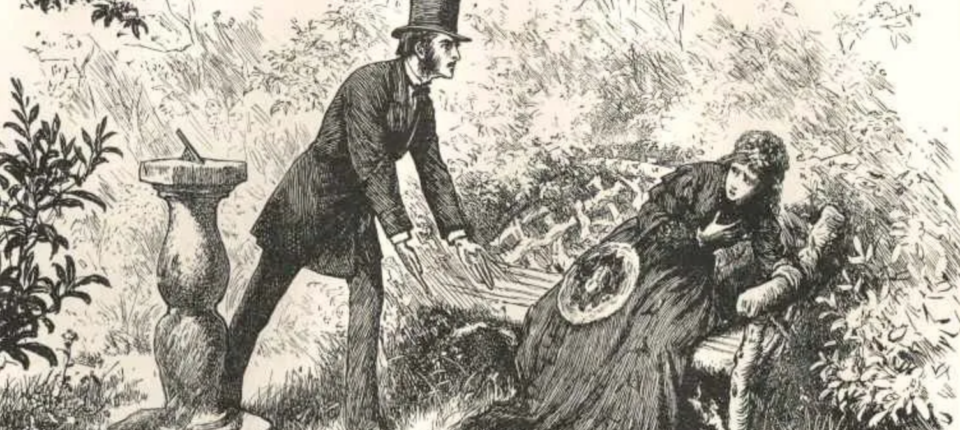When he died, on June 9th, 1870, Charles Dickens left behind an unfinished novel. It seems to have been a murder mystery of sorts, called The Mystery of Edwin Drood, and he had only written six of the intended twelve installments. Dickens had told his good friend and future biographer John Forster a rough idea of the plot, but left no plan or outline for the remainder; “Nothing had been written of the main parts of the design excepting what is found in the published numbers; there was no hint or preparation for the sequel in any notes of chapters in advance. . . the evidence of matured designs never to be accomplished, intentions planned never to be executed, roads of thought marked out never to be traversed, goals shining in the distance never to be reached, was wanting here. It was all a blank.” Thus, when he passed away (of a stroke), he left the novel’s central mystery… well, a mystery.
Scholar John Cuming Walters conveys just how well-done Edwin Drood is, prior to its abrupt stop, emphasizing the cruel irony of its lack of completion:
Edwin Drood conveys the idea also that it would have been a singularly complete book, no detail overlooked, no hint unused, no character wasted, no portion unfinished. It bears no sign of haste, of immature planning, of uncertain result. A cold, hard, inexorable logic pervades it. It is literary clockwork, scrupulously designed and fashioned, every particle of mechanism perfect and polished, every adjustment made; and it is set going and proceeds with regularity; but the designer alone had the key to its secret operation, its marvel of movement to an appointed and fateful stroke.
The novelist and critic George Gissing wrote of Edwin Drood‘s lack of clues about the identity of the murder in the first half: “One defect forced upon our attention,” wrote , “is characteristic of Dickens: his inability to make skilful revelation of circumstances which, for the purpose of the story, he has kept long concealed. This skill never came to him. . . There can be no doubt that the revealing of the mystery of ‘Edwin Drood’ would have betrayed the old inability.”
The story is fascinating, though inconclusive by the halfway point. It is about a group of people whose stories interconnect in the fictional town of Cloisterham (it’s modeled on Rochester), namely the young man Edwin Drood, and his opium-addled choirmaster uncle John Jasper. Edwin is ambivalent about his betrothal to a young woman named Rosa Bud (Jasper’s choir student and the object of his lust), which is further complicated when two siblings (Neville and Helena Landness) arrive in the town. Neville falls in love with Rosa, and while Helena becomes her best friend. And then, Edwin disappears; some of his things are found by the river (interesting, given that the word “DROWNED” appears in his name). Jasper suggests that the jealous Neville might be responsible for this, and then a mysterious figure named Dick Datchery appears, and keeps a close watch on Jasper, especially when he visits his usual opium den, a strange place run by a woman known as Her Royal Highness the Princess Puffer. It’s intimated that Datchery is a disguise, but it’s unknown which of the novel’s many characters might be underneath. It’s also thought, given Dickens’s lifelong interest in detectives, that Datchery is in fact a detective coming to solve the crime. (I, personally, am partial to the idea that it’s Helena Landness, because I love lady detective and a disguised lady detective at that, but that’s just me.)
Since shortly after Dickens’s death in 1870, writers (and musical theater playwrights) have attempted to pick up where he left off, trying to solve the novel’s central murder themselves and write an acceptable second half and ending.
The strangest, though, was published in 1873, by an American printer named Thomas Power James. He claimed that the spirit of Charles Dickens had appeared to him and dictated the rest of the novel through him, and published a full version of the novel. Arthur Conan Doyle, noted spiritualist, found credence in this, and endorsed this “ghostwritten” continuation, saying that Dickens’s style remained consistent throughout the story. This edition endured in America far longer than it should have.
That The Mystery of Edwin Drood ultimately became the consummate mystery might have intrigued Dickens, who was fascinated with the interplay between novels and their ability to galvanize performative, public sensation. It’s a frustrating and fascinating final chapter in the oeuvre of the nineteenth century’s greatest storyteller.

















